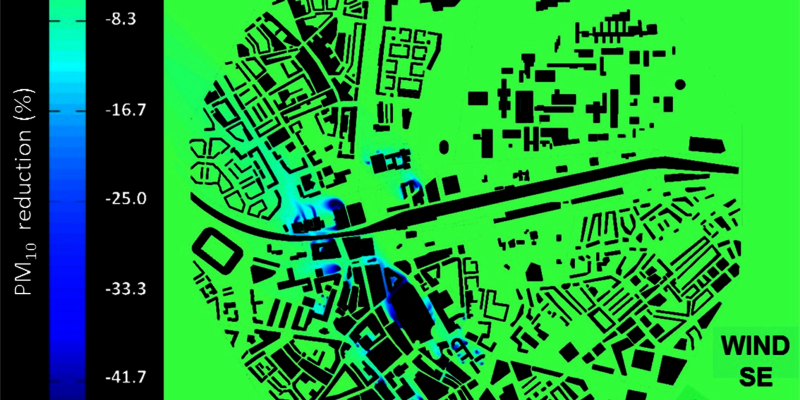
- Research
- 27/10/2016
Air purification in parking garages reduces particulate matter
Eliminating particulate matter from underground car parks in the city center of Eindhoven can result in local reductions in the concentration of these particles of up to 50%. Researchers from Eindhoven University of Technology (TU/e) came to this conclusion on the basis of air flow models and computer simulations of the city center. The simulations prove the effectiveness of an initiative by the environmental innovation company ENS Technology to use underground car parks as air purification sites, or ‘lungs of the city’.
Under the supervision of Professor of Building Physics Bert Blocken, the Eindhoven researchers made a very detailed computational grid of the city center of Eindhoven. This grid covered an area of 5.1 square kilometers and included 16 underground car parks. The effect on the concentration of particulate matter in the city center air was simulated, following the reduction of the particles inside the underground car parks by a total of 99 or 594 air purification systems.
Substantial impactThe placing of 99 air purification systems inside the car parks generally decreases particulate matter concentrations outside the car parks locally by up to 10 percent. But with the use of 594 air purification units, a substantially larger area – up to a kilometer from the underground car parks – is affected where at least 10 percent reduction in particulate matter is observed. In certain locations this reduction even peaked to 40 or 50 percent less. Blocken: “I had certainly expected an effect, but not as substantial as this.” While the simulations have their limitations compared to practice – the force and direction of the wind, for example, can be particularly influential – the researchers conclude that this approach is an effective way of improving the air quality in a city center.
Lungs of the city
The idea of capturing particulate matter in underground car parks originates from the environmental innovation company ‘ENS Technology’. “Since the ventilation systems of the underground car parks are in contact with the streets and shopping zones above, these garages have a considerable influence on the air quality in the city center”, says ENS director Lia van de Vorle. “By eliminating the particulate matter in these places and by ventilating clean air into the city, underground car parks act as cleansing lungs of the city.”
Pilot
The Eindhoven researches used the specifics of the air purification systems of ENS Technology in their simulations. “The company has developed an innovative technology that turns fine dust into coarse dust”, says Van de Vorle. “This is achieved by efficiently charging airborne fine dust particles and capturing them on a grounded collection plate.” A pilot project in an underground car park has generated a perceptible improvement in the air quality around the car park over the past two years. “Now that the TU/e study has proven the effectiveness of this idea on the scale of the city center of Eindhoven, we are preparing a pilot in which the real-life effects can be validated in Eindhoven”, Van de Vorle says. “Eventually, we plan to implement air purification systems in a variety of infrastructural structures such as tunnels, train and bus stations, viaducts and traffic junctions.”
Source: Persteam TU/e
Discussion